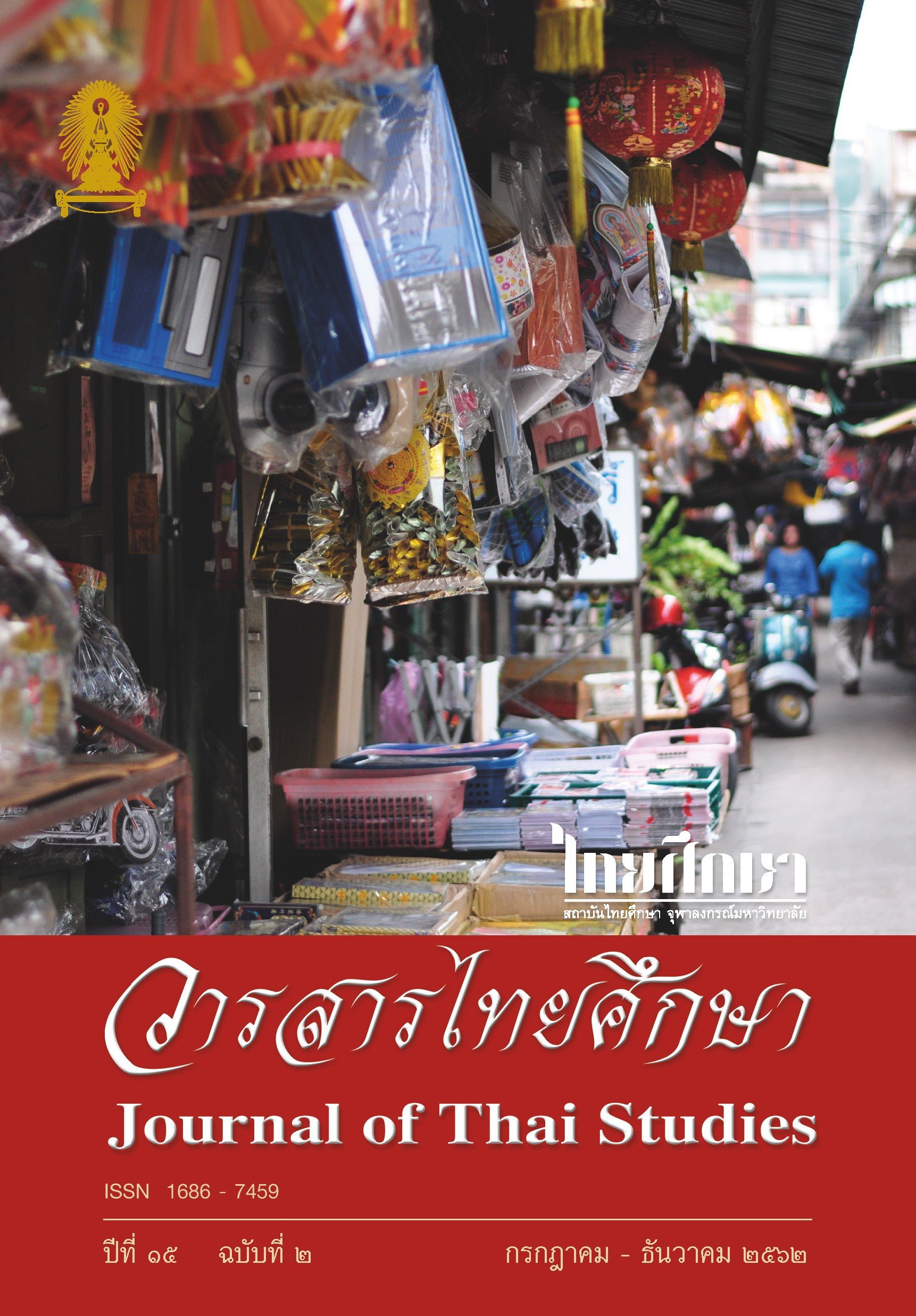“Magical Objects” in Contemporary Thai Paranormal Literary Works
Main Article Content
Abstract
This article aims to detail a study of “Magical Objects” in six contemporary Thai paranormal literary works: Kaew Rahu, Kularp Rattikal, Petch Aknee, Sroisaengjan, Rak Bun, and Tongpayamarn. The research found that in these surreal pieces of contemporary Thai literature, the magic of traditional characters of both ancient and modern literature is represented. The key features of the magic were the ability to fulfill one’s desire and to give protection to the owner. While the representation of this magic was derived from literature, the creation of new features of the magic is related to contemporary society. The creators of the magic in contemporary Thai literature include gods and humans; while the owner of the magic in contemporary Thai literature changed from ancient literature, in which the owner was a king or royal prince of the king, to become ordinary people who had life problems and were full of greed. This has led to changing the role of the magic from supporting the concept of ethical virtue to representing the concept of human greed. This is a reflection of a character’s action that tried to use the magic in order to solve problems and fulfill one’s desire. In addition, magic in contemporary literature clearly reflects the modern capitalistic Thai society.
Downloads
Article Details

This work is licensed under a Creative Commons Attribution-NonCommercial-NoDerivatives 4.0 International License.
Journal of Thai studies is licensed under a Creative Commons Attribution-Noncommercial-NoDerivatives4.0 Intenational (CC BY-NC-ND 4.0) licence, unless otherwise stated. Plese read our Policies page for more information on Open Access, copyright and permissions.
References
Anantasan, S. (2015). Supernatural Motifs in the Sang Thong Tale. Ramkhamhaeng University Journal Humanities Edition. 34, 2, 42–62.
Asita. (2014). Thongphayaman. Bangkok: Khamtokham.
Bangsen, W. (1991). Study of the plot and motif in literature verse readings, types of tales from the written editions in the National Library. (Master’s thesis). Srinakharinwirot University, Bangkok, Thailand.
Chomani. (2011). Rak bun. Bangkok: Saeng dao.
Iosakun, N. “yon roi chi-em-o 18 pi: phai khukkham athippatai thang ahan khong prathet thai [retracing 18 years of GMO: A dangerous threat to the food sovereignty of Thailand”. [webblog]. Retrieved from http://www.greenpeace.org
Kaeokao. (2003). kaeorahu [Kaeorahu.] (4th ed.) Bangkok: Phueandi.
Khamchu, N. (2014). Shoes in Thai literature. Wanwithat 14, 130-149.
Khobut. [webblog]. Retrieved from http://vajirayana.org/
Mangmun, W. (2010). “A Study of Thai literary motifs: Prakawut.” Damrong Journal, 9, 1, 171-188.
Nathalang, S. (2010). Tritsadi katichonwittaya: withi nai kan wikro tumnan puenban [Folklore theory: analysis methodology of myths and folktales]. (2nd ed.). Bangkok: Chulalongkorn University Press.
Patchusanon, S. and Thanotwanit, T. (2017). “The Creation of Magic Motifs in the Fantasy Novel, the White Road”. Journal of Humanities and Social Sciences 25, 47, 149–170.
Phirasathian, U. (1986). An Analytical study of tale types and motifs in Pannasa Jatakas. (Master’s thesis). Chulalongkorn University, Bangkok, Thailand.
Phongsakorn. (2012). Kulaprattikan. (2nd ed.). Bangkok: Groove Publishing.
Phongsakorn. (2015). Phetakkhani. Bangkok: Groove Publishing.
Phongsakorn. (2015). Soisaengchan. (3rd ed.). Bangkok: Groove Publishing.
Phuaphatnakun, C. (2010). ‘Magical Objects’ and ‘Inventions’ in Phra Aphai Mani: Convergence of imagination and science.” In Sunthon that. Nakhon Pathom: Faculty of Liberal Arts Mahidol University.
Rueangrong, A. (1996). An analytical study of Kaeo-Na-Ma. (Master’s thesis). Chulalongkorn University, Bangkok, Thailand.
Sunthonphu. (2010). Phra aphai mani. Bangkok: BOWT.
Tantiphimonchut, K. (1990). Analysis of the incredible stories in the poems of Sunthorn Phu. (Master’s thesis). Naresuan University, Phitsanulok, Thailand.
The Royal Institute of Thailand. (2013). Photchananukrom chabap ratchabandittayasathan phoso 2554 chaloemphrakiat phrabatsomdetphrachaoyuhua nueang nai okat phraratchaphithi maha mongkhon chaloemphrachonphansa 7 rop 5 thanwakhom 2554. [Royal Institute Dictionary 2011, In Honor of the His Majesty, the King on the auspicious occasion of the 7th Birthday Anniversary, 5 December 2011]. Bangkok: The Royal Institute of Thailand.
Thitathan Na Thalang, S. (1989). Laksana nueaha wannakhadi thai. nai Ekkasan kan son chut wicha thai sueksa: Arayatham nuai thi 6-11 [Teaching documents for Thai studies: Civilization Unit 6-11]. (13rd ed.). Bangkok: Sukhothai Thammathirat Open University.
Thitathan Na Thalang, S. (1996). Nai thongthin mi nithan lae kanlalen… Kansueksa khati chon nai boribot thang sangkhom thai [Local stories and entertainment: A study of folklore in the context of Thai society]. Bangkok: Matichon.
Yibunyan, S. (2005). An Analyze of Magical Objects in the Dramas of Ordinary Thai People. (Master’s thesis). Srinakharinwirot University, Bangkok, Thailand.


